Water-Spray-Cooled Quasi-Isothermal Compression Method: Water-Spray Flow Improvement
Abstract
:1. Introduction
2. Mathematical Model
- (1)
- The water-spray is assumed to be evenly distributed in the compression chamber;
- (2)
- Heat transfer between the water on the surface of the piston and the air is ignored;
- (3)
- The external forces on the motion of the water spray have been not taken into account;
- (4)
- The air is treated as an ideal gas.
2.1. Air Temperature and Air Pressure
2.2. Heat Transfer
2.3. Flow Mass and Heat-Transfer Area of the Water Spray in the Compression Chamber
2.4. Power Consumption of the System
2.4.1. Power Consumption of Compression
2.4.2. Power Consumption of Atomization
2.4.3. Ideal Total Power Consumption
3. Methods
3.1. Objective Function
3.2. Improvement Principle
3.3. Algorithm
3.4. Relaxation Factor K
3.5. Number of Iterations N
4. Analysis of Results
4.1. Total Energy Consumption of the Compression System
4.2. Impact of Water-Spray Speed
4.3. Influence of Rotation Speed
4.4. Influence of Water Pressure
5. Conclusions
- (1)
- The water-spray flow of the improved scheme was larger than that of the uniform scheme in the early stage, but decreased and approached 0 in the later stage. The cumulative mass in the compression chamber was the integral of the flow. The cumulative mass of the improved scheme rose fast, and the peak value was high. Later, it decreased and approached 0. However, the uniform scheme still had some remaining mass in the later stage.
- (2)
- Analysis of the dynamics of the compression system revealed that temperature and pressure lagged behind changes in the water-spray flow. Compared with uniform water spray, the effective water-spray quality in the heat-exchange process increased due to the injection of water spray in advance, which could effectively reduce the total power consumption of the compression system.
- (3)
- The water-spray speed and the compressor speed were both related to the heat-transfer time, which affected the performance of the improvement algorithm. When the water-spray speed was lower than the piston speed by seven times, the improvement algorithm could effectively reduce the total power consumption.
- (4)
- The working pressure of the atomizing nozzle was related to the power consumption of the atomization, which affected the effect of the improvement algorithm, and reducing the working pressure made the improvement effect more obvious.
Author Contributions
Funding
Conflicts of Interest
References
- Statistical Review of World Energy. 2020. Available online: https://www.bp.com/en/global/corporate/energy-economics/statistical-review-of-world-energy.html (accessed on 16 June 2020).
- Ziółkowski, P.; Kowalczyk, T.; Lemański, M.; Badur, J. On energy, exergy, and environmental aspects of a combined gas-steam cycle for heat and power generation undergoing a process of retrofitting by steam injection. Energy Convers. Manag. 2019, 192, 374–384. [Google Scholar] [CrossRef]
- Global Energy Review. 2021. Available online: https://www.iea.org/reports/global-energy-review-2021/renewables (accessed on 1 April 2021).
- Sima, A.; Fajri, P.; Sabzehgar, R.; Asrari, A. Optimal management of residential energy storage systems in presence of intermittencies. J. Build. Eng. 2019, 29, 101149. [Google Scholar]
- Habiba, A.; Luo, L.; Abbas, B. Demand and application of energy storage technology in renewable energy power system. ASRJETS 2017, 36, 75–84. [Google Scholar]
- Saidur, R.; Rahim, N.A.; Hasanuzzaman, M. A review on compressed-air energy use and energy savings. Renew. Sustain. Energy Rev. 2010, 14, 1135–1153. [Google Scholar] [CrossRef]
- Aneke, M.; Wang, M. Energy storage technologies and real life applications—A state of the art review. Appl. Energy 2016, 179, 350–377. [Google Scholar] [CrossRef] [Green Version]
- Lund, H.; Salgi, G. The role of compressed air energy storage (CAES) in future sustainable energy systems. Energy Convers. Manag. 2009, 50, 1172–1179. [Google Scholar] [CrossRef]
- King, M.; Jain, A.; Bhakar, R.; Mathur, J.; Wang, J. Overview of current compressed air energy storage projects and analysis of the potential underground storage capacity in India and the UK. Renew. Sustain. Energy Rev. 2021, 139, 110705. [Google Scholar] [CrossRef]
- Budt, M.; Wolf, D.; Span, R.; Yan, J. A review on compressed air energy storage: Basic principles, past milestones and recent developments. Appl. Energy 2016, 170, 250–268. [Google Scholar] [CrossRef]
- Roumeliotis, I.; Mathioudakis, K. Evaluation of water injection effect on compressor and engine performance and operability. Appl. Energy 2010, 87, 1207–1216. [Google Scholar] [CrossRef]
- Coney, M.; Stephenson, P.; Malmgren, A.; Linnemann, C.; Morgan, R.; Richards, R.; Huxley, R.; Abdallah, H. Development of a reciprocating compressor using water injection to achieve quasi-isothermal compression. In Proceedings of the 2002 Inter-national Compressor Engineering Conference, West Lafayette, IN, USA, 16–19 July 2002. [Google Scholar]
- Patil, V.C.; Acharya, P.; Ro, P.I. Experimental investigation of water spray injection in liquid piston for near isothermal compression. Appl. Energy 2020, 259, 114182. [Google Scholar] [CrossRef]
- Bollinger, B. Technology Performance Report SustainX Smart Grid Program; U.S. Department of Energy: Washington, DC, USA, 2015.
- An Elegant Method of Capturing Heat Energy and Regenerating Useful Energy. LightSail, Inc. Available online: http://www.lightsail.com/ (accessed on 16 March 2017).
- Jia, G.; Xu, W.; Cai, M.; Shi, Y. Micron-sized water spray-cooled quasi-isothermal compression for compressed air energy storage. Exp. Therm. Fluid Sci. 2018, 96, 470–481. [Google Scholar]
- Odukomaiya, A.; Abu-Heiba, A.; Gluesenkamp, K.R.; Abdelaziz, O.; Jackson, R.K.; Daniel, C.; Graham, S.; Momen, A.M. Thermal analysis of near isothermal compressed gas energy storage system. Appl. Energy 2016, 179, 948–960. [Google Scholar] [CrossRef]
- Chen, H.; Peng, Y.; Wang, Y.; Zhang, J. Thermodynamic analysis of an open type isothermal compressed air energy storage system based on hydraulic pump/turbine and spray cooling. Energy Convers. Manag. 2020, 204, 112293. [Google Scholar] [CrossRef]
- Qin, C.; Loth, E. Simulation of spray direct injection for compressed air energy storage. Appl. Therm. Eng. 2016, 95, 24–34. [Google Scholar] [CrossRef]
- Heidar, J.; Soltani, M.; Nathwani, J. Assessment of the Huntorf compressed air energy storage plant performance under enhanced modifications. Energy Convers. Manag. 2020, 209, 112662. [Google Scholar]
- Qin, C.; Loth, E. Liquid piston compression efficiency with droplet heat transfer. Appl. Energy 2014, 114, 539–550. [Google Scholar] [CrossRef]
- Dib, G.; Haberschill, P.; Rullière, R.; Revellin, R. Thermodynamic investigation of quasi-isothermal air compression/expansion for energy storage. Energy Convers. Manag. 2021, 235, 114027. [Google Scholar] [CrossRef]
- Cengel, Y.A.; Boles, M.A. Thermodynamics: An Engineering Approach, 4th ed.; McGraw-Hill Education: New York, NY, USA, 2002; p. 89. [Google Scholar]
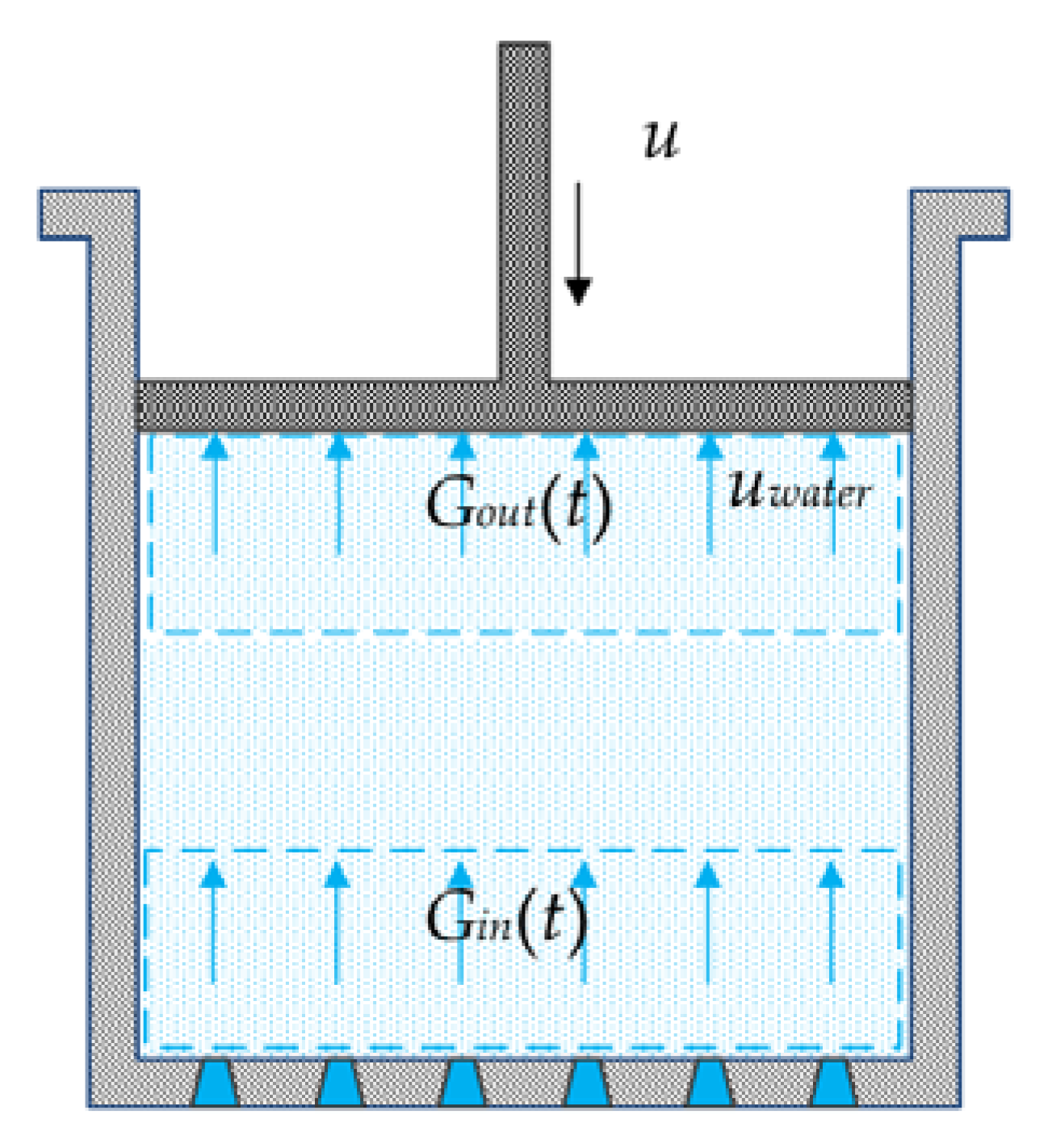
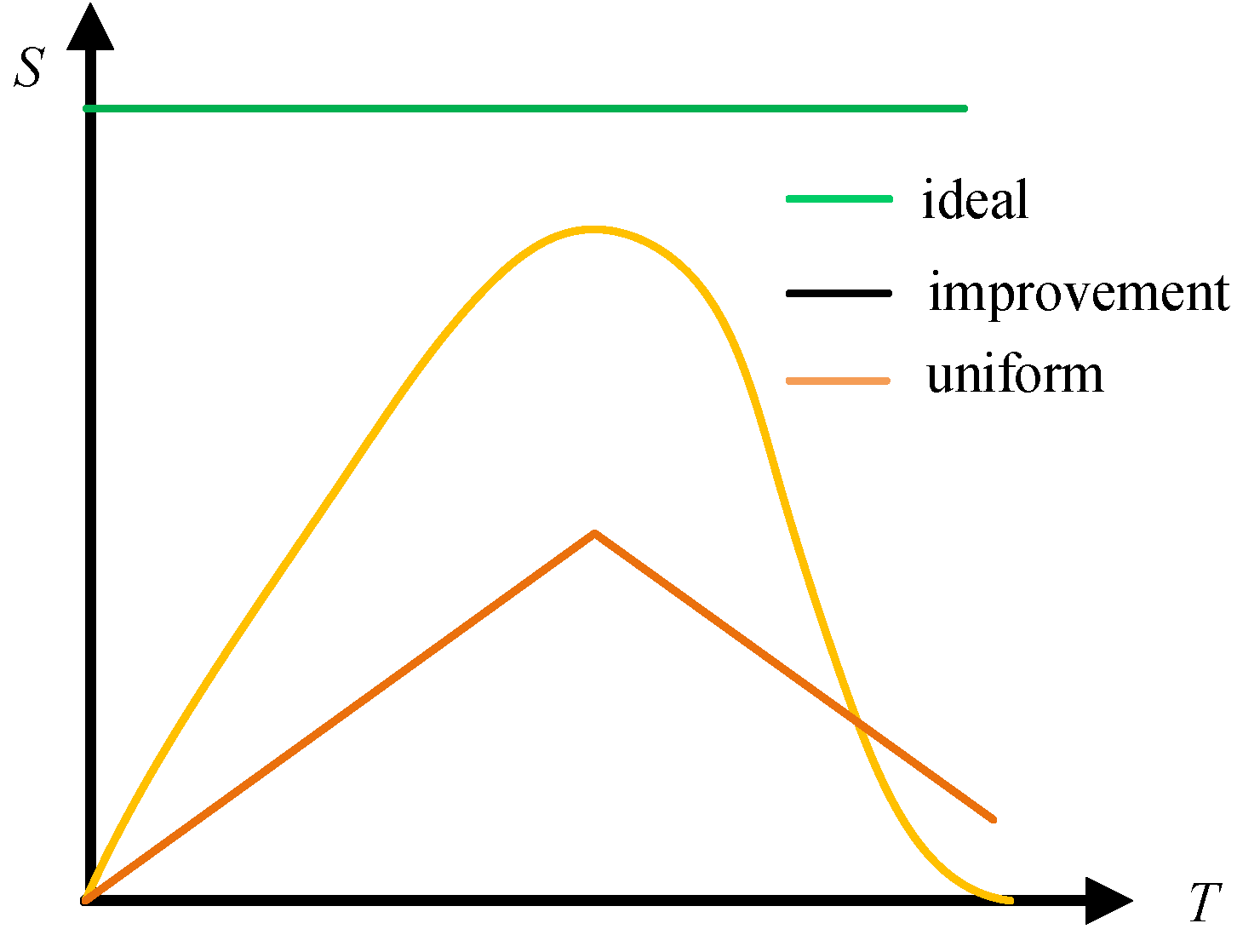

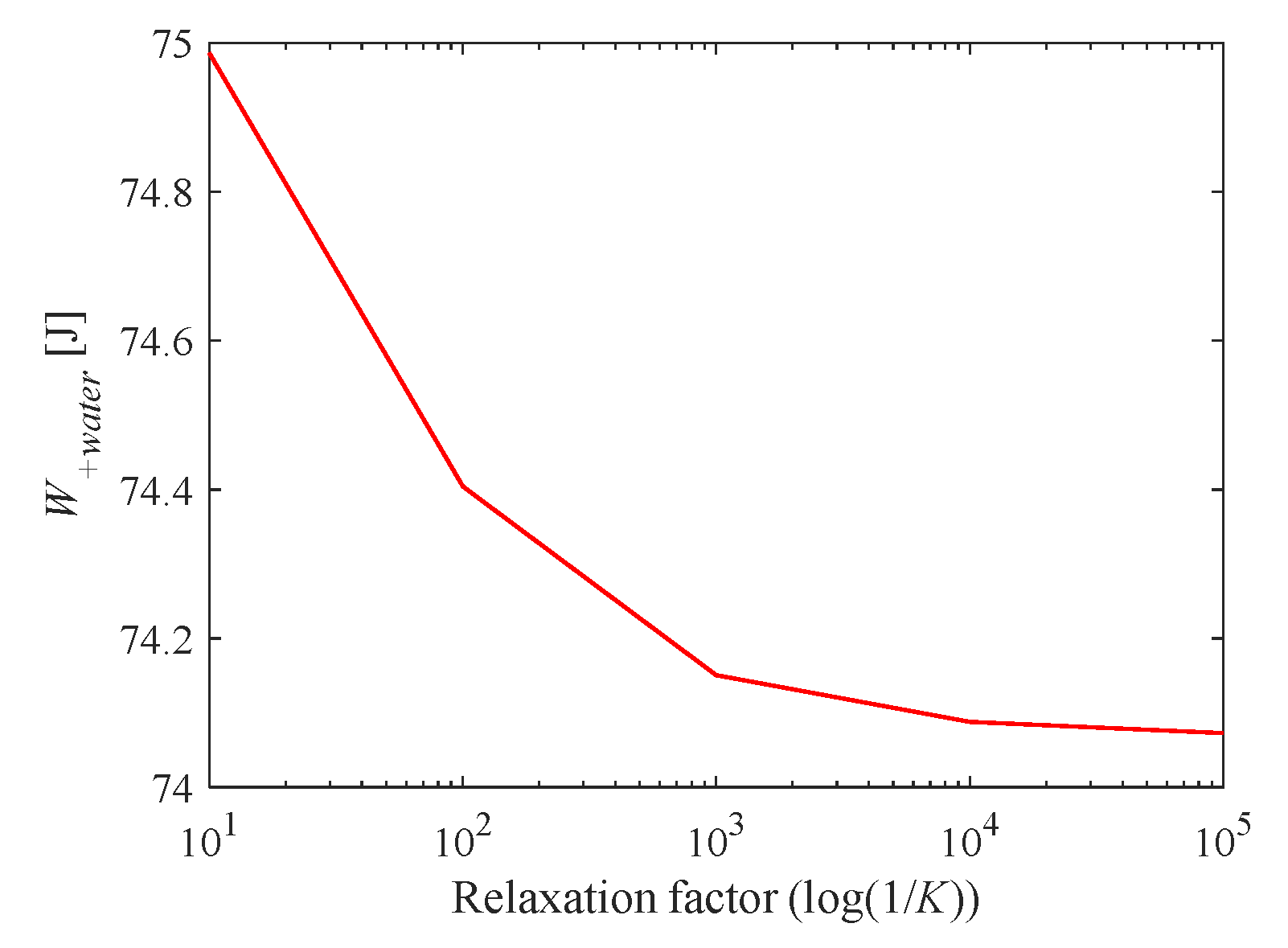

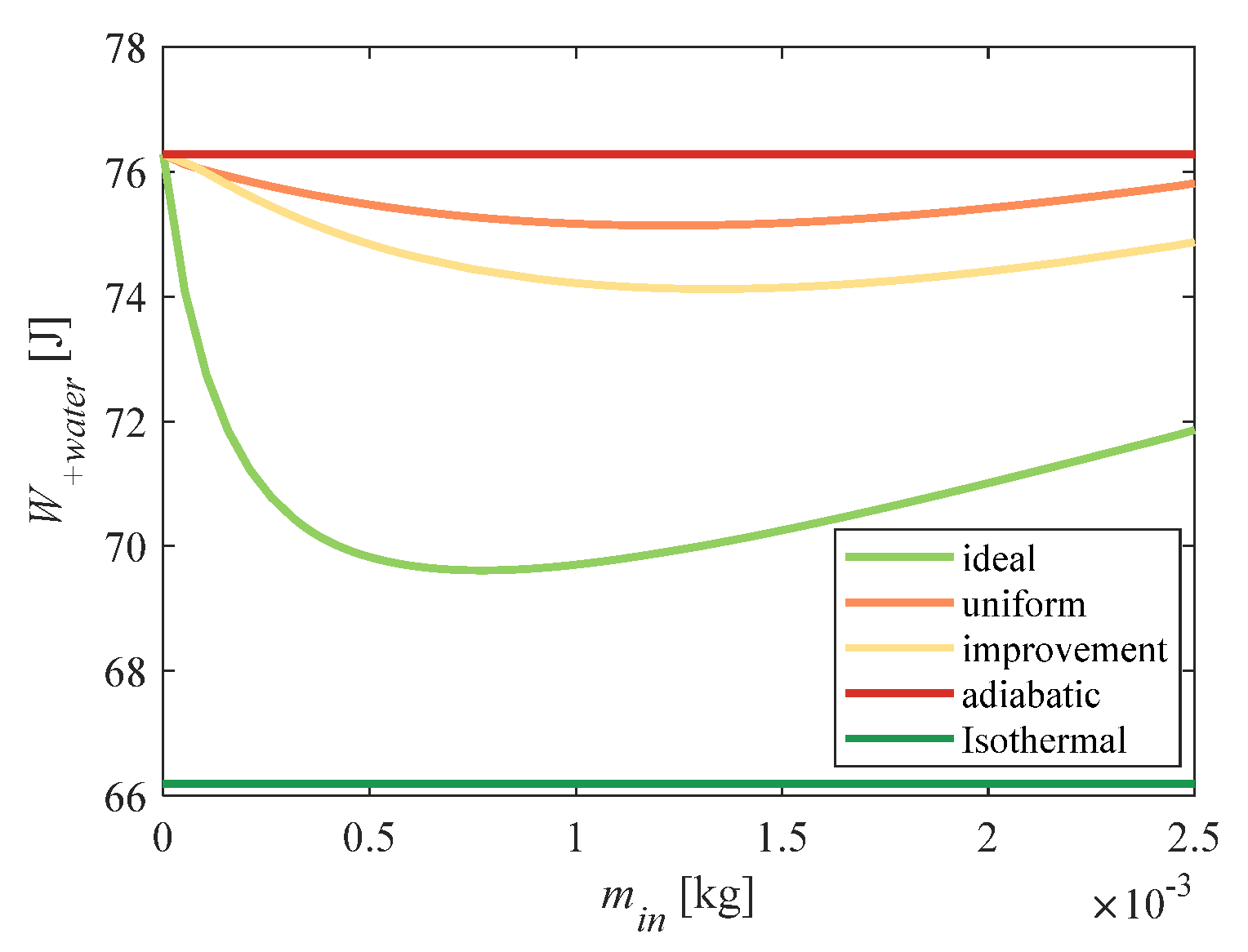
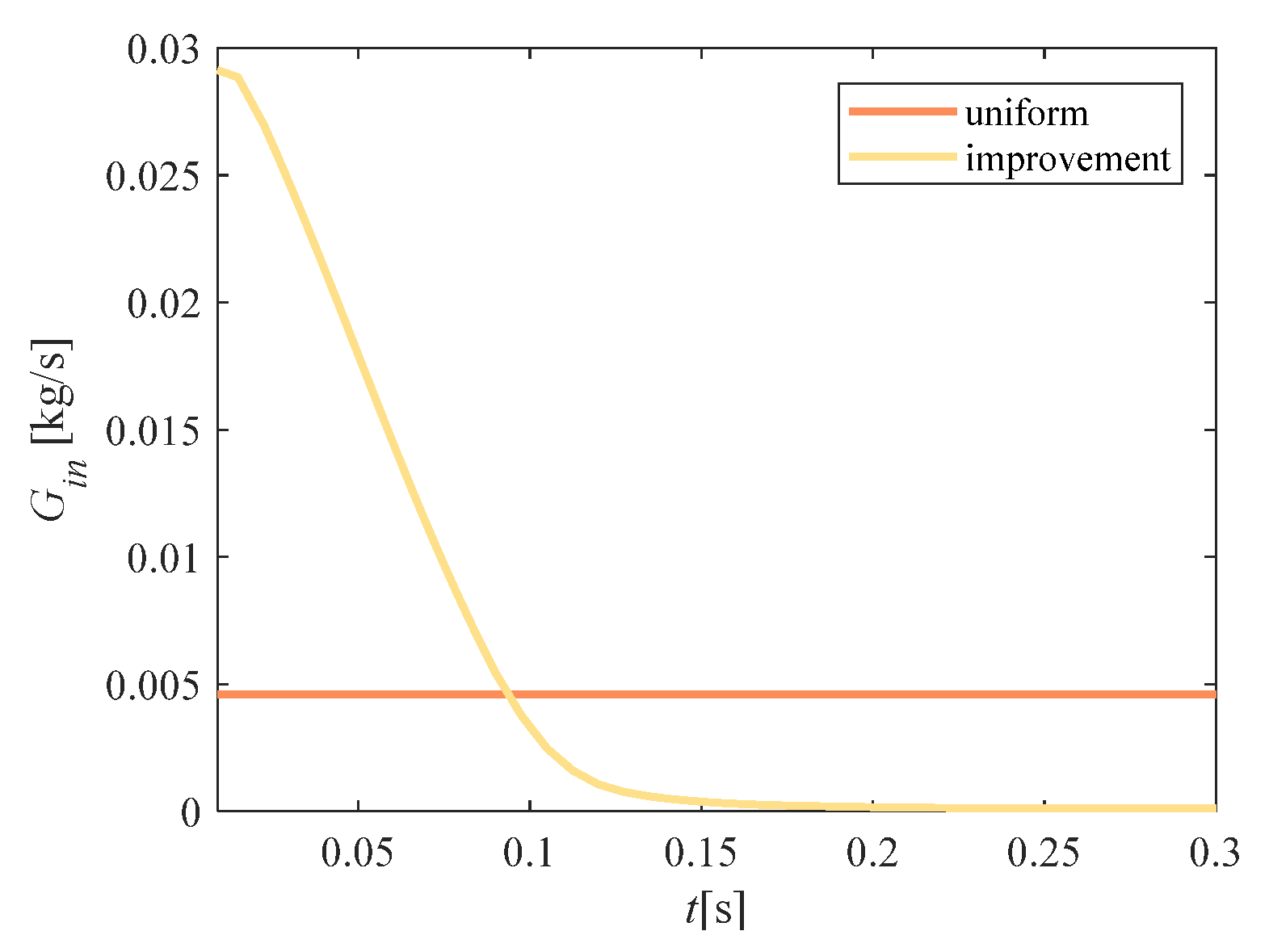
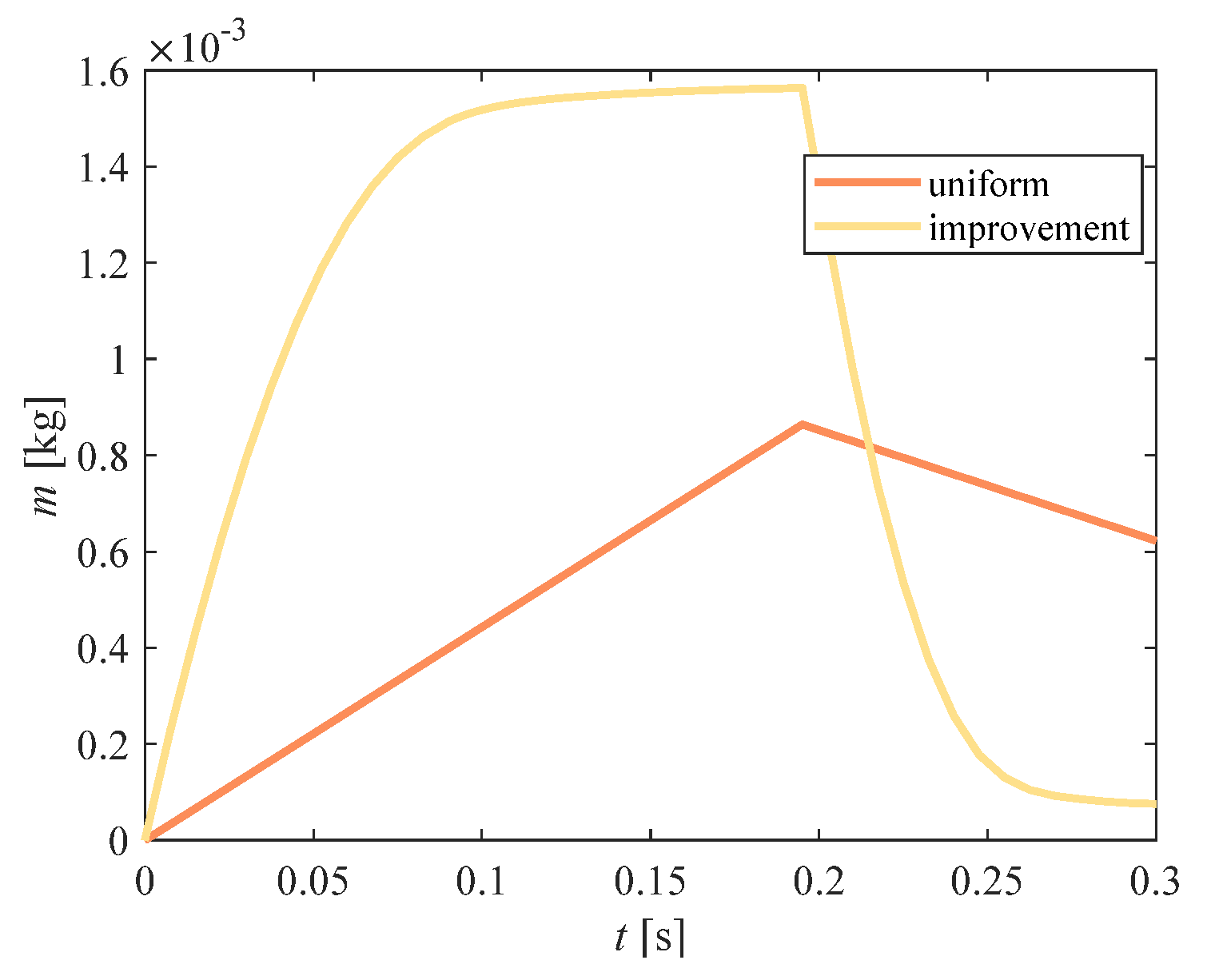
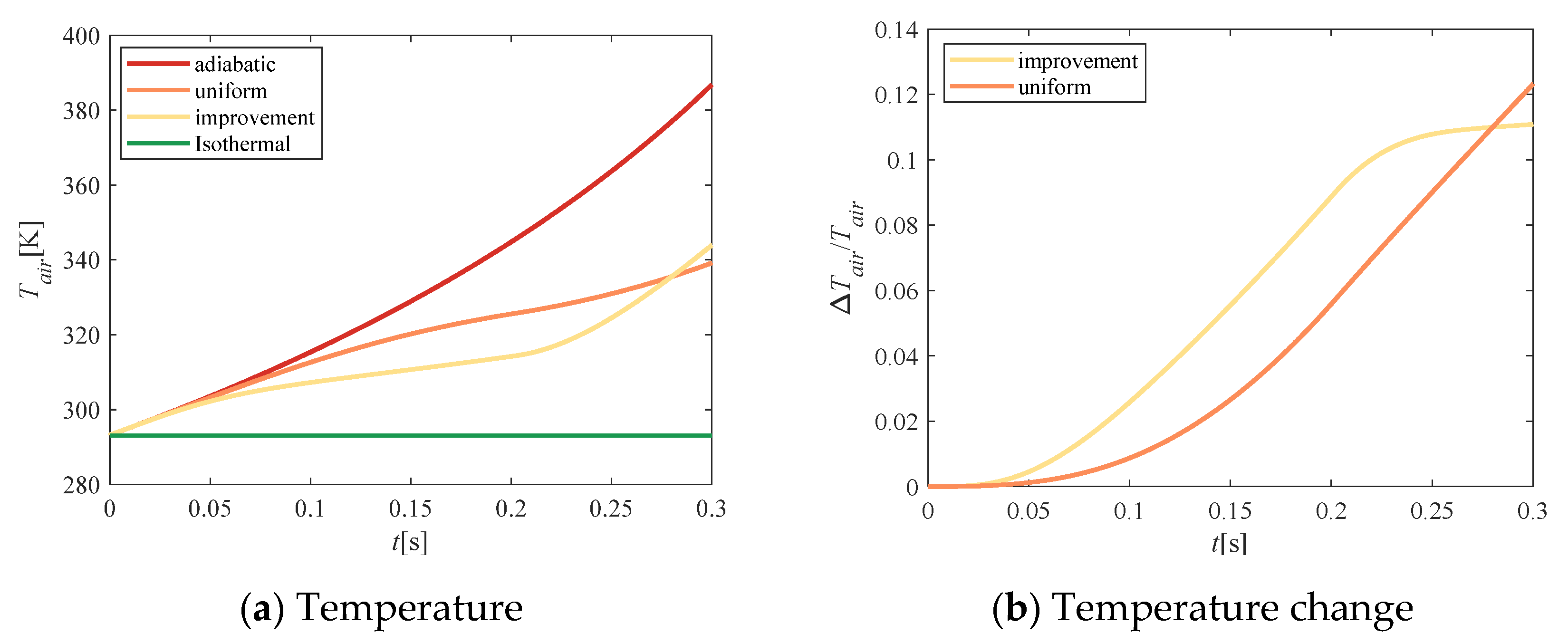
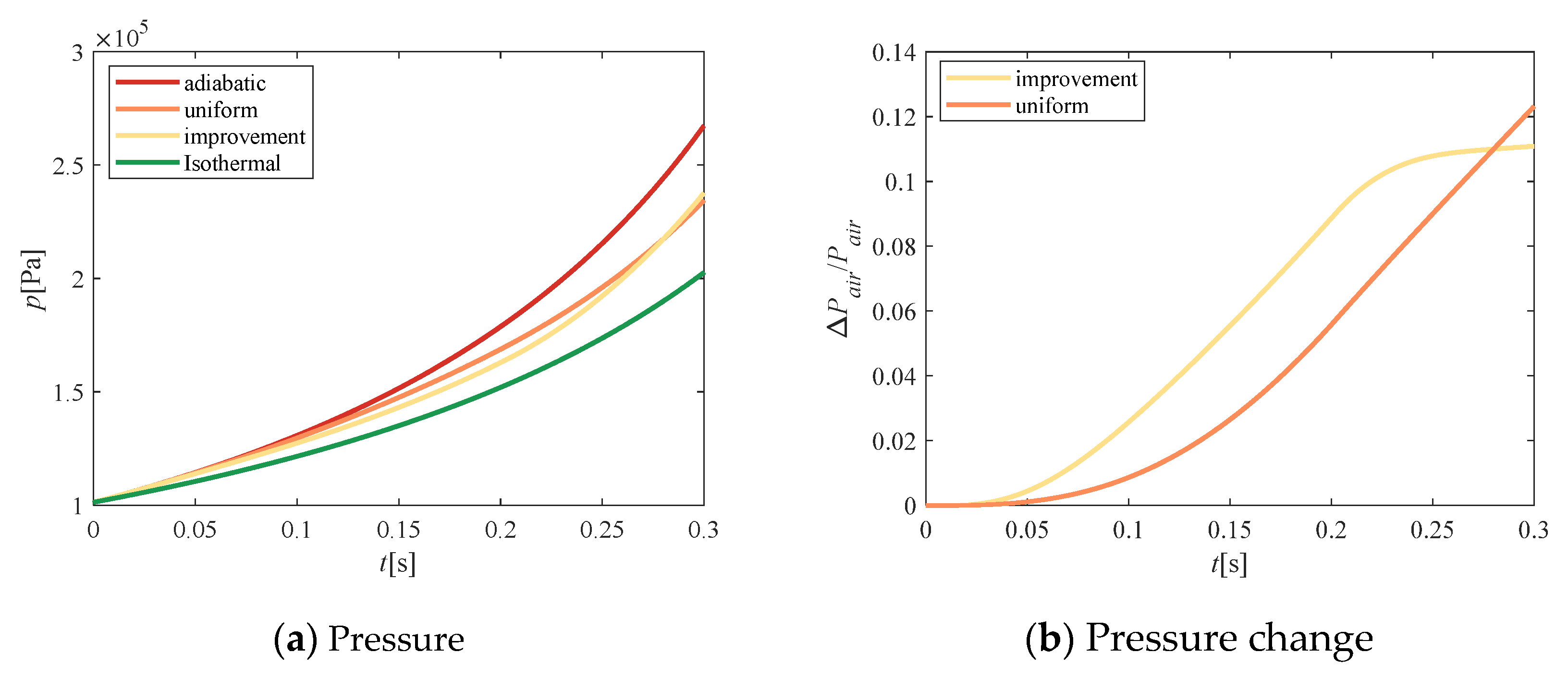
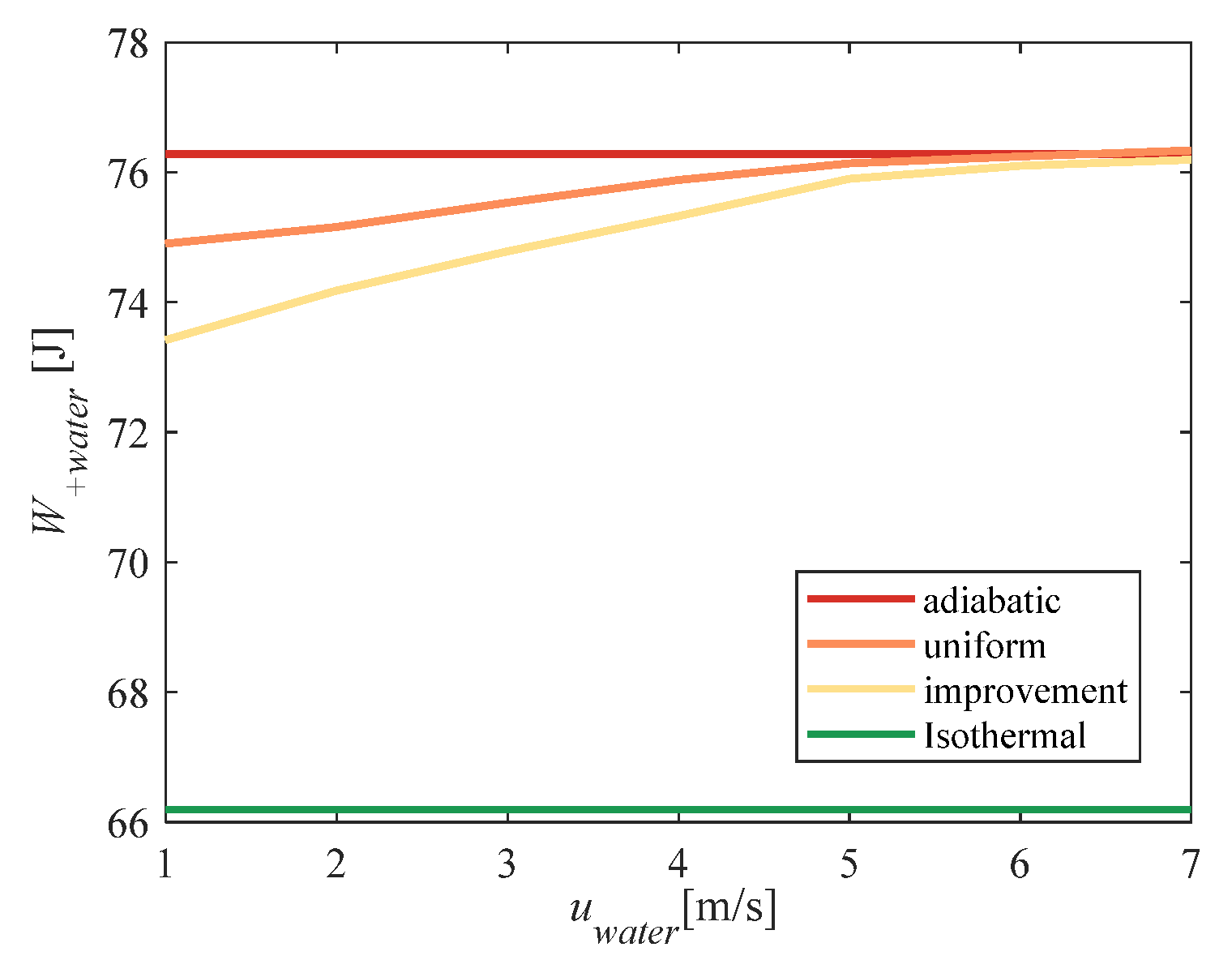
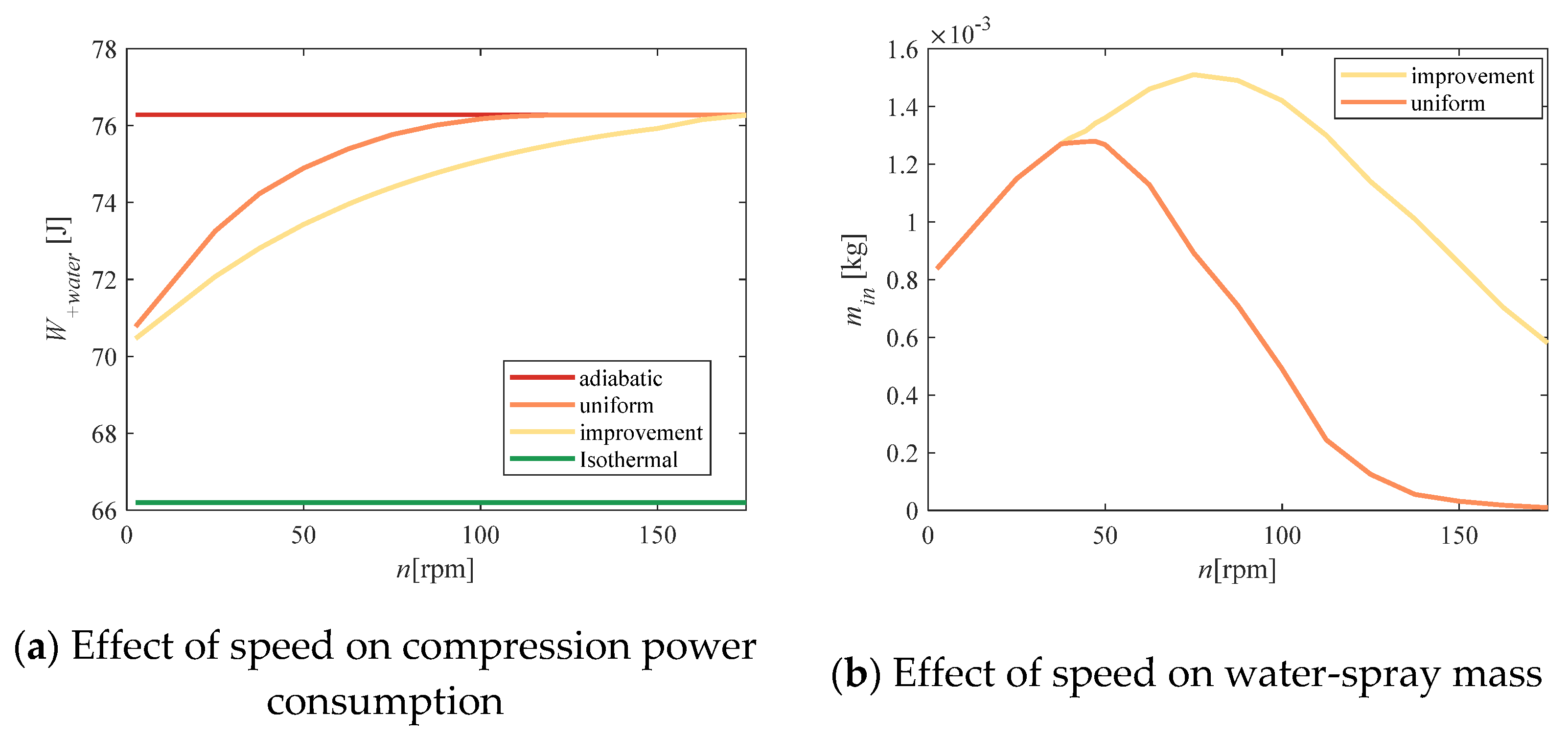
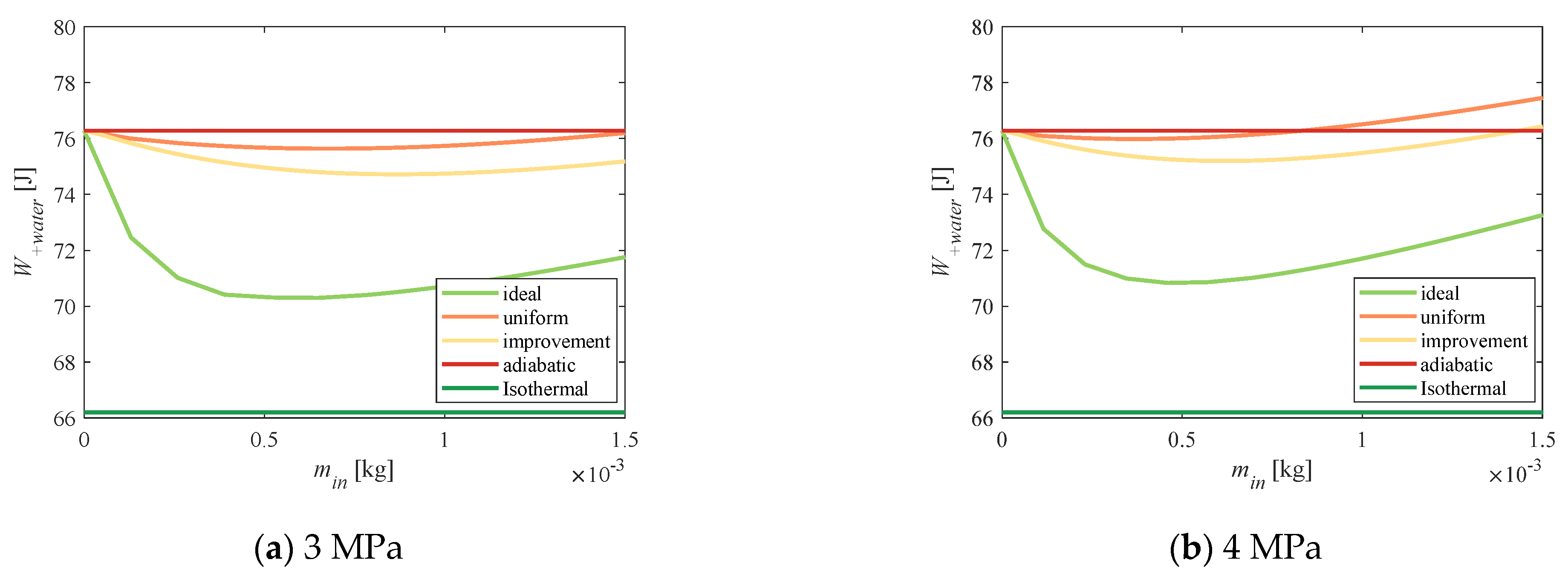

| Authors | Jia et al. [16] | Patil et al. [20] |
|---|---|---|
| Compression speed (rpm) | 60 | 12 |
| Diameter (μm) | 10–100 | - |
| Injection pressure | 5 MPa | 483 kPa |
| Flow rate | 0.416 g/cycle | 1.25 L/min |
| Generated work/compression work | 19.4% | 59.51% |
| Isothermal efficiency | 81.7% | 95% |
| Parameter Name | Symbol | Value |
|---|---|---|
| Compression chamber diameter | D/m | 0.1 |
| Compression chamber length | L/m | 0.12 |
| Compression chamber volume | V0/m3 | 9.36 × 10−4 |
| Compression ratio | Γ | 2~6 |
| Rotating speed | n/rpm | 5~90 |
| Water density | ρwater/kg/m3 | 1000 |
| Initial air temperature | T0/K | 293 |
| Initial air pressure | p0/Pa | 1 × 105 |
| Heat transfer coefficient | h/J/(m2·K) | 35 |
| Nozzle Diameter (mm) | Water-Spray Particle Sizes under Different Water Pressures (μm) | |||
|---|---|---|---|---|
| 2 MPa | 3 MPa | 4 MPa | 5 MPa | |
| 0.4 | 28.7 | 23.3 | 20.9 | 19.6 |
| 0.6 | 32.6 | 28.4 | 26.2 | 23.5 |
| 0.8 | 38.5 | 34.9 | 31.2 | 27.3 |
| Section | Relaxation Factor | Compression Ratio | Water-Spray Speed (m/s) | Water Pressure (MPa) | Rotating Speed (rpm) |
|---|---|---|---|---|---|
| 3.4 | 0.0005~1 | 2 | 0.4 | 2 | 50 |
| 3.5, 4.1 | 0.001 | 2 | 0.4 | 2 | 50 |
| 4.2 | 0.001 | 2 | 0.2~5 | 2 | 50 |
| 4.3 | 0.001 | 2 | 0.1~0.7 | 2 | 25~175 |
| 4.4 | 0.001 | 2 | 0.4 | 2~5 | 50 |
Publisher’s Note: MDPI stays neutral with regard to jurisdictional claims in published maps and institutional affiliations. |
© 2021 by the authors. Licensee MDPI, Basel, Switzerland. This article is an open access article distributed under the terms and conditions of the Creative Commons Attribution (CC BY) license (https://creativecommons.org/licenses/by/4.0/).
Share and Cite
Jia, G.; Nian, X.; Xu, W.; Shi, Y.; Cai, M. Water-Spray-Cooled Quasi-Isothermal Compression Method: Water-Spray Flow Improvement. Entropy 2021, 23, 724. https://doi.org/10.3390/e23060724
Jia G, Nian X, Xu W, Shi Y, Cai M. Water-Spray-Cooled Quasi-Isothermal Compression Method: Water-Spray Flow Improvement. Entropy. 2021; 23(6):724. https://doi.org/10.3390/e23060724
Chicago/Turabian StyleJia, Guanwei, Xuanwei Nian, Weiqing Xu, Yan Shi, and Maolin Cai. 2021. "Water-Spray-Cooled Quasi-Isothermal Compression Method: Water-Spray Flow Improvement" Entropy 23, no. 6: 724. https://doi.org/10.3390/e23060724






